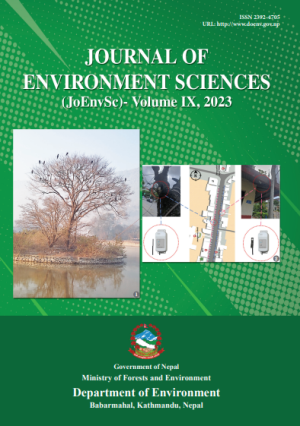Assessing and Comparing Environmental Assessment Pathways in Nepal
DOI:
https://doi.org/10.3126/jes.v9i1.56486Keywords:
Alternative Analysis, Environmental Assessment Reports, Scoping Document, Strategic Environmental Analysis, Terms of ReferenceAbstract
National Environmental Impact Assessment Guideline (NEIAG), 1993, is the major guiding legal document for the project level environmental assessment in Nepal which has provided the concrete methods for impact identification, prediction and evaluation for the proposals to be implemented. Environment Protection Act, 1997 (EPA-1997) and Environmental Protection Regulations, 1997 (EPR-1997) highlighted the categories and thresholds of the proposals requiring Initial Environmental Examination (IEE) and Environmental Impact Assessment (EIA), requirements of public hearing particularly for EIA, environmental monitoring by concerned ministries for IEE and Ministry of Environment (MoE) for EIA, Environmental Audit for EIA, punishments of five to twenty-fifty lakhs for implementing proposals without the approval of Environmental Assessment (EA) reports, timeline of fifteen days public notice, approval of IEE report within twenty-one days and sixty days for EIA report, provisions for Supplementary Environmental Impact Assessment (SEIA) and brief formats of the reports. Environment Protection Act, 2019 (EPA-2019) and Environment Protection Regulations, 2020 (EPR-2020) has advanced the existing provisions of EPA-1997 and EPR-1997. Brief Environmental Study (BES) has been added as a new project level environmental assessment required for the particular projects. EPA-2019 and EPR-2020 has empowered the provincial and local governments for conducting and approving the proposals to be executed in respective level of governments. Public hearing is made mandatory for all levels of environmental assessments. Proposals implemented without the approval and/or violating the provisions of approved reports are charged with the amount of fine up to five lakhs for BES, up to ten lakhs for IEE, and up to fifty lakhs for EIA. Requirement of Strategic Environmental Analysis (SEA) for plans, policies and programs is a new legal concept of environmental assessment at strategic level. The timeline for approval of Scoping Document (SD), Terms of Reference (ToR), BES and IEE report is within fifteen days of report submission, within sixty days of report submission for EIA report, submission of final BES, IEE and EIA report is mandatory within two years of SD and ToR approval and initiation of proposal implementation is within three years of EA report approval. The recent legal provisions also have provided room for updating of BES report, IEE report and Environmental Management Plan (EMP) as per the requirement of the proposal implementation. Blacklisting the consultants for not assuring the standards of reports as required by the government, detail formats of reports, language of the reports to be in Nepali language and alternative analysis of the mitigation measures for particular impact and suggestion of the best mitigation measures are some additional provisions in the newer legal provisions.




